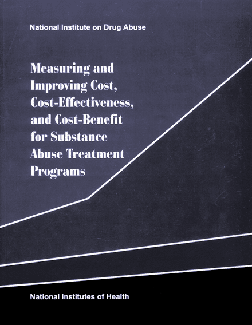|
A new NIDA resource provides substance abuse treatment program managers with tools to calculate the costs of their programs and to investigate the relationship between these costs and various treatment outcomes. These analyses can help program managers reduce costs and improve treatment while demonstrating to funders that the programs deserve support.
"In recent years, competition for substance abuse program funds has become more intense," says NIDA Director Dr. Alan I. Leshner. "At the same time, program costs and the relationship between these costs and outcomes have come under greater scrutiny. Program managers need to learn how to analyze their programs so that they can provide concrete evidence that the programs are a good investment of public and private funds."
 |
The new manual, Measuring and Improving Cost, Cost-Effectiveness, and Cost-Benefit for Substance Abuse Treatment Programs, was written for NIDA by Dr. Brian Yates of American University in Washington, D.C. The manual is designed to guide professionals from diverse disciplines and educational backgrounds through the collection and analysis of data on program costs, treatment procedures, patient processes, and program outcomes. The manual provides step-by-step instructions, exercises, and worksheets and explains how to analyze data using graphs and spreadsheets. Numerous examples from real-life situations illustrate how the analyses can be used in different programs.
In the section on cost analysis, the manual describes methods for collecting data on the costs of treatment personnel, space, equipment, and other expenses, including donated resources, such as volunteer services or equipment. By incorporating all resources-both paid and donated-into the analysis, program managers can help other service providers attempting to replicate the program see what costs will be if they cannot obtain the same level of donated resources.
The manual also describes how to measure patient outcomes. Outcome measures may be nonmonetary, such as the number of days drug-free or number of days employed. Measures may also be monetary, such as cost savings resulting from reduced use of criminal justice, social, and health services as an outcome of substance abuse treatment.
The data on costs and patient outcomes can be used together to produce cost-effectiveness and cost-benefit analyses. Cost-effectiveness analyses show the relationship between a program's costs and nonmonetary patient outcomes. These analyses can be used to compare one program to another or to compare different components of the same program. A program or component is considered more cost-effective than another when it either produces the same outcome at a lower cost or produces a better outcome at the same cost.
Cost-benefit analyses show the relationship between a program's costs and monetary patient outcomes. Like cost-effectiveness analysis, cost-benefit analysis can be used to compare one program to another or to compare different components within the same program. Cost-benefit analyses can be used noncomparatively as well. For example, a cost-benefit analysis may find that every $1 spent on a particular substance abuse treatment program results in an average savings of $5 to taxpayers due to reductions in criminal justice and medical costs.
Program managers can use cost-effectiveness and cost-benefit analyses to evaluate their programs to determine how to enhance outcomes and reduce costs. These analyses can also give funding sources and policymakers concrete evidence of a program's effectiveness.
"Analyzing the costs, cost-effectiveness, and cost-benefits of substance abuse treatment programs is sometimes complex because there are so many variables to consider," says Dr. Peter Delany of NIDA's Services Research Branch. "This manual, which was field-tested by program managers, provides clear and concise explanations of these analyses for managers who are interested in evaluating their programs."
To Receive This Resource
Free copies of Measuring and Improving Cost, Cost-Effectiveness, and Cost-Benefit for Substance Abuse Treatment Programs are available from the National Clearinghouse for Alcohol and Drug Information (NCADI), P.O. Box 2345, Rockville, MD 20847-2345; (800) 729-6686 or (301) 468-2600; TDD number: (800) 487-4889; fax: (301) 468-6433;
e-mail: info@health.org. The manual is also available in the Health Services Research section of NIDA's home page at www.drugabuse.gov.
|